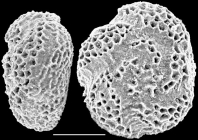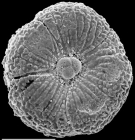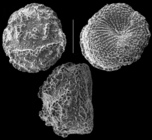WoRMS taxon details
Conorbella Hofker, 1951
112192 (urn:lsid:marinespecies.org:taxname:112192)
accepted
Genus
Discorbina pulvinata Brady, 1884 accepted as Conorbella pulvinata (Brady, 1884) (type by original designation)
- Species Conorbella clarionensis (McCulloch, 1977)
- Species Conorbella erecta (Sidebottom, 1908)
- Species Conorbella imperatoria (d'Orbigny, 1846)
- Species Conorbella lavelaensis (McCulloch, 1981)
- Species Conorbella playablancaensis (McCulloch, 1977)
- Species Conorbella pulvinata (Brady, 1884)
- Species Conorbella semihispida (McCulloch, 1977)
- Species Conorbella trinidadensis (McCulloch, 1981)
- Species Conorbella concinna (Brady, 1884) accepted as Tretomphaloides concinnus (Brady, 1884)
- Species Conorbella corrugata (Millett, 1903) accepted as Angulodiscorbis corrugatus (Millett, 1903)
- Species Conorbella earlandi Collins, 1958 accepted as Pannellaina earlandi (Collins, 1958)
- Species Conorbella patelliformis (Brady, 1884) accepted as Pileolina patelliformis (Brady, 1884)
- Species Conorbella socorroensis (McCulloch, 1977) accepted as Glabratella socorroensis (McCulloch, 1977) (unaccepted > superseded combination)
- Species Conorbella tuberocapitata (Chapman, 1900) accepted as Neoconorbina tuberocapitata (Chapman, 1900)
marine, brackish, fresh, terrestrial
feminine
Hofker, J. (1951). The Foraminifera of the Siboga Expedition. Part 3. <em>Siboga Expeditie, monograph.</em> 4: 1-513.
page(s): p. 448, 466 [details] Available for editors [request]
[request]
page(s): p. 448, 466 [details] Available for editors
Hayward, B.W.; Le Coze, F.; Vachard, D.; Gross, O. (2025). World Foraminifera Database. Conorbella Hofker, 1951. Accessed through: World Register of Marine Species at: https://www.marinespecies.org/aphia.php?p=taxdetails&id=112192 on 2025-04-03
Date
action
by
2006-09-08 06:50:23Z
changed
Martinez, Olga
![]() The webpage text is licensed under a Creative Commons
Attribution 4.0 License
The webpage text is licensed under a Creative Commons
Attribution 4.0 License
Nomenclature
original description
Hofker, J. (1951). The Foraminifera of the Siboga Expedition. Part 3. <em>Siboga Expeditie, monograph.</em> 4: 1-513.
page(s): p. 448, 466 [details] Available for editors [request]
[request]
basis of record Gross, O. (2001). Foraminifera, <B><I>in</I></B>: Costello, M.J. <i>et al.</i> (Ed.) (2001). <i>European register of marine species: a check-list of the marine species in Europe and a bibliography of guides to their identification. Collection Patrimoines Naturels,</i> 50: pp. 60-75 (look up in IMIS) [details]
page(s): p. 448, 466 [details] Available for editors
basis of record Gross, O. (2001). Foraminifera, <B><I>in</I></B>: Costello, M.J. <i>et al.</i> (Ed.) (2001). <i>European register of marine species: a check-list of the marine species in Europe and a bibliography of guides to their identification. Collection Patrimoines Naturels,</i> 50: pp. 60-75 (look up in IMIS) [details]
Other
additional source
Neave, Sheffield Airey. (1939-1996). Nomenclator Zoologicus vol. 1-10 Online. <em>[Online Nomenclator Zoologicus at Checklistbank. Ubio link has gone].</em> , available online at https://www.checklistbank.org/dataset/126539/about [details]
additional source Loeblich, A. R.; Tappan, H. (1987). Foraminiferal Genera and their Classification. Van Nostrand Reinhold Company, New York. 970pp., available online at https://books.google.pt/books?id=n_BqCQAAQBAJ [details] Available for editors [request]
[request]
additional source Loeblich, A. R.; Tappan, H. (1987). Foraminiferal Genera and their Classification. Van Nostrand Reinhold Company, New York. 970pp., available online at https://books.google.pt/books?id=n_BqCQAAQBAJ [details] Available for editors
From editor or global species database
Diagnosis Test planoconvex, trochospiral, rapidly enlarging chambers appearing crescentic and sutures oblique, thickened, and depressed on the strongly convex spiral side, peripheral carina rounded to sharply angular, sutures flush and may be obscured by the radial ornamentation on the flat disclike umbilical side; wall calcareous, surface of spiral side strongly rugose, with heavy pustules, rugae, and spinules that may be aligned concentrically, surface of umbilical side with radially aligned striae or rows of granules; aperture a small, interiomarginal, umbilical slit. Holocene; Pacific. (Loeblich & Tappan, 1987, Foraminiferal Genera and Their Classification) [details]






